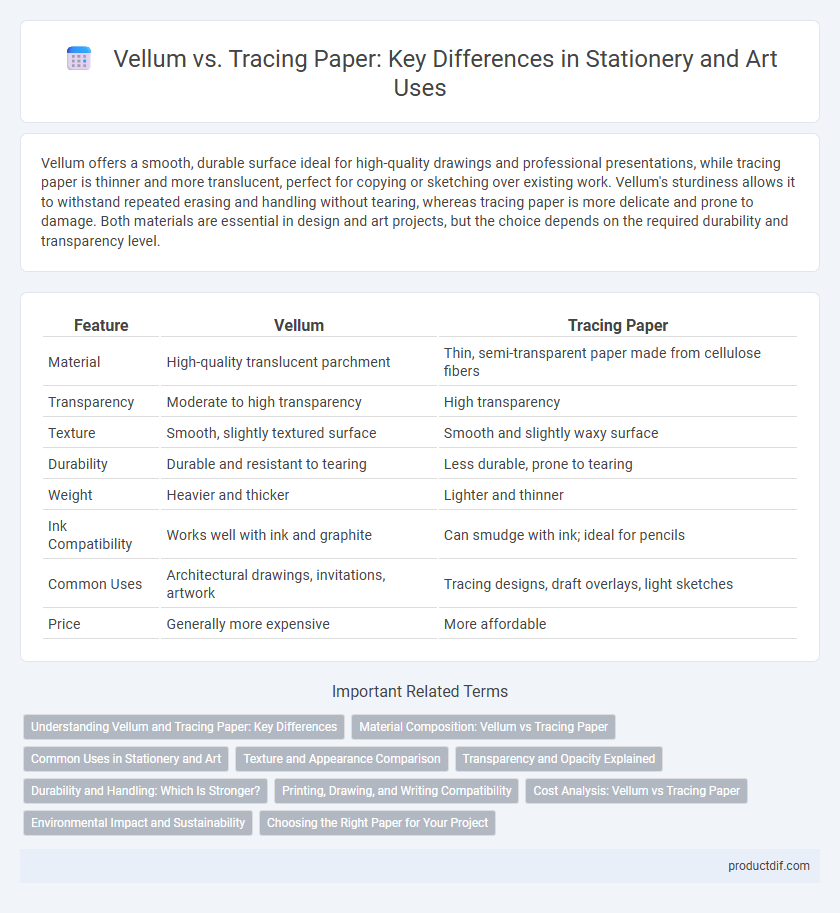Vellum offers a smooth, durable surface ideal for high-quality drawings and professional presentations, while tracing paper is thinner and more translucent, perfect for copying or sketching over existing work. Vellum's sturdiness allows it to withstand repeated erasing and handling without tearing, whereas tracing paper is more delicate and prone to damage. Both materials are essential in design and art projects, but the choice depends on the required durability and transparency level.
Table of Comparison
| Feature | Vellum | Tracing Paper |
|---|---|---|
| Material | High-quality translucent parchment | Thin, semi-transparent paper made from cellulose fibers |
| Transparency | Moderate to high transparency | High transparency |
| Texture | Smooth, slightly textured surface | Smooth and slightly waxy surface |
| Durability | Durable and resistant to tearing | Less durable, prone to tearing |
| Weight | Heavier and thicker | Lighter and thinner |
| Ink Compatibility | Works well with ink and graphite | Can smudge with ink; ideal for pencils |
| Common Uses | Architectural drawings, invitations, artwork | Tracing designs, draft overlays, light sketches |
| Price | Generally more expensive | More affordable |
Understanding Vellum and Tracing Paper: Key Differences
Vellum is a translucent, durable paper made from cotton or wood pulp, often used for architectural drawings and calligraphy due to its smooth surface and ability to withstand erasing. Tracing paper is thinner, more transparent, and less durable, designed specifically for copying or transferring images by placing it over an original drawing. The key differences lie in their thickness, transparency, durability, and intended use, with vellum offering greater stability and longevity compared to tracing paper.
Material Composition: Vellum vs Tracing Paper
Vellum is traditionally made from animal skin, typically calf, sheep, or goat, providing a durable, translucent surface ideal for archival-quality documents and artwork. Tracing paper, in contrast, is manufactured from cellulose fibers derived primarily from wood pulp, treated to achieve high transparency and smooth texture at a lower cost. The differing material compositions result in vellum's characteristic strength and longevity, while tracing paper offers flexibility and affordability for temporary sketches and design overlays.
Common Uses in Stationery and Art
Vellum is widely used for high-quality calligraphy, invitations, and professional art prints due to its smooth, durable surface that accepts ink and paint well. Tracing paper is preferred for design drafts, architectural plans, and layering sketches because of its translucent properties that allow easy overlay and transfer of images. Both materials serve distinct but complementary roles in stationery and art, supporting diverse creative and technical tasks.
Texture and Appearance Comparison
Vellum features a smooth, slightly glossy surface with a subtle translucency that enhances fine detail visibility, making it ideal for precise artistic and drafting applications. Tracing paper tends to have a more matte finish and a thinner, more delicate texture, offering higher transparency for overlay tracing but less durability than vellum. The distinct tactile quality of vellum provides a firmer feel, whereas tracing paper is lightweight and flexible, influencing their respective uses in design and architectural drafting.
Transparency and Opacity Explained
Vellum offers a smooth surface with moderate transparency, allowing for clear visibility of underlying sketches while maintaining some opacity for crisp detail work. Tracing paper features higher transparency, enabling easy replication of designs by placing it directly over original artwork for precise tracing. Both materials balance transparency and opacity differently, catering to specific needs in design, drafting, and artistic projects.
Durability and Handling: Which Is Stronger?
Vellum offers superior durability compared to tracing paper, as it is thicker and more resistant to tears and creases, making it ideal for frequent handling and long-term projects. Tracing paper, while thinner and easier to fold, tends to be more fragile and prone to damage under heavy use or repeated handling. For projects requiring strength and longevity, vellum provides a sturdier and more reliable surface.
Printing, Drawing, and Writing Compatibility
Vellum offers a smooth, durable surface ideal for fine printing and detailed drawing, maintaining sharpness and clarity in ink and pencil work. Tracing paper, thinner and more translucent, excels in overlay applications but may cause ink to bleed or smudge, limiting its compatibility with certain printers and writing tools. Both materials suit different artistic and technical needs, with vellum preferred for archival-quality prints and tracing paper for design drafts requiring transparency.
Cost Analysis: Vellum vs Tracing Paper
Vellum typically costs more per sheet than tracing paper due to its higher quality and durability, making it a preferred choice for professional artists and architects. Tracing paper is more affordable and widely accessible, suitable for students and casual use where budget constraints are significant. When evaluating cost-effectiveness, vellum offers long-term value through reusability, while tracing paper provides a low-cost option for temporary or disposable applications.
Environmental Impact and Sustainability
Vellum is typically made from animal skin, resulting in a higher environmental impact due to resource-intensive processing and ethical concerns, while tracing paper is produced from wood pulp that can be recycled, making it generally more sustainable. Tracing paper often contains fewer chemicals and is biodegradable, though its production may contribute to deforestation if not sourced from certified sustainable forests. Choosing tracing paper with FSC certification can further reduce environmental footprint compared to traditional vellum alternatives.
Choosing the Right Paper for Your Project
Vellum offers a smooth, semi-translucent surface ideal for detailed ink work and archival-quality projects, while tracing paper provides higher transparency for easy copying and layering. Selecting between vellum and tracing paper depends on the project's need for durability, texture, and translucency, with vellum suited for presentations and tracing paper favored in drafting and design tasks. Consider weight, opacity, and finish to ensure the paper enhances precision and clarity in your stationery and artistic projects.
Vellum vs Tracing Paper Infographic

 productdif.com
productdif.com